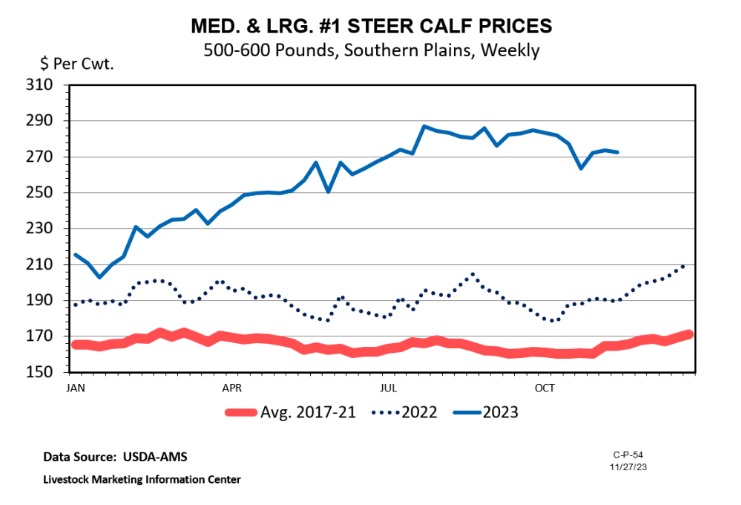By Ryan McGeeney
Cattle market prices are as high as they’ve been in a decade. That’s good news for producers who have been able to maintain their herds in recent years, but a missed opportunity for those who weren’t.

Throughout most of the year, both futures and cash markets for steers, calves and more marked a vast improvement over 2022. By the last week of November, prices for medium and large No. 1 steer calves (weighing 500 to 600 pounds) were above $270 per hundredweight, more than $80 per hundredweight higher than the same time in 2022 and more than $100 higher than the average from 2017-2021.
James Mitchell, assistant professor and extension economist in the Department of Agricultural Economics and Agribusiness at the University of Arkansas System Division of Agriculture, said that the benefits of high prices largely fell to those with access to good grazing and forage.
“It was an exciting year in terms of markets for cattle,” Mitchell said. “Cattle prices leading up to the fall were as high as we’ve seen them in 10 years — that had lots of people excited about the future. On the production side, it was exciting depending on who you asked.”
A wide swath of droughty conditions has made its way down the middle of the United States over the last several years — affecting first the Northern Plains states such as Montana and Idaho in 2021-2022, then the Southern Plains of Kansas and Texas and finally the Southeast in 2023.
“About three-quarters of Arkansas was heavily affected,” Mitchell said. “The southeastern United States has been hit incredibly hard by drought. All of our neighbors to the east — Tennessee, Mississippi, Alabama, Georgia, Kentucky, Florida — are in a pretty tough spot, still very much in a drought. So for them, there’s not much they can do with these high prices, because they don’t have any grass or forage. There was nothing they could really do this winter, in terms of retaining calves.
“So you’ve got significant portions of cattle-producing states suffering through drought, forcing them to shrink or liquidate their herds because of a lack of forage,” he said. “When you have three consecutive years of that, you’re going to have a tightening of beef cow availability, which means you’ve got fewer calves being born each year. So you have tighter and tighter supplies, which of course leads to higher prices — assuming demand holds steady.”
In January, the U.S. Department of Agriculture reported that the total U.S. beef cattle inventory was at its lowest since 1962, declining more than 3 percent from the previous year to 28.9 million head. The inventory reported an entire cattle inventory of 89.3 million. Mitchell said he believes the forthcoming USDA Cattle Inventory report, expected in January 2024, will reflect a fourth consecutive year of contracting cattle supply in the United States.
Of course, there’s almost nothing that can’t price itself out of the market. At a certain point, Mitchell said, consumer resiliency will give way to more competitive pricing for — in this case — other animal proteins, such as poultry, pork and fish.
“People consume less of something when it gets more expensive — it’s just a law of economics,” he said.
Mitchell said that rebuilding the country’s beef cattle inventory will be a multi-year process — one that can’t really even begin under the persistence of drought.
“Pastures are going to have to recover before we see any discussion of expanding cattle numbers,” he said. “Even if that does occur, it’s going to take a couple of years for that expansion to be noticed. We don’t have the cows; it’s going to take a year to develop heifers, another year for them to give us calves, and so on. So we’re looking at a few more years of declining cattle numbers.
“An important thing that’s different from 2014-2015, is that it’s going to be more expensive to buy back in and expand herds,” Mitchell said. “Interest rates are higher than they were 10 years ago. We expanded the herds very rapidly in 2014, we did that with low interest rates — so capital was inexpensive. That should lead to more careful calculation in terms of how we decide to expand herds.”
To learn about extension programs in Arkansas, contact your local Cooperative Extension Service agent or visit www.uaex.uada.edu. Follow us on X and Instagram at @AR_Extension. To learn more about Division of Agriculture research, visit the Arkansas Agricultural Experiment Station website: https://aaes.uada.edu/. Follow on X at @ArkAgResearch. To learn more about the Division of Agriculture, visit https://uada.edu/. Follow us on X at @AgInArk.
About the Division of Agriculture
The University of Arkansas System Division of Agriculture’s mission is to strengthen agriculture, communities, and families by connecting trusted research to the adoption of best practices. Through the Agricultural Experiment Station and the Cooperative Extension Service, the Division of Agriculture conducts research and extension work within the nation’s historic land grant education system.
The Division of Agriculture is one of 20 entities within the University of Arkansas System. It has offices in all 75 counties in Arkansas and faculty on five system campuses.
The University of Arkansas System Division of Agriculture offers all its Extension and Research programs to all eligible persons without regard to race, color, sex, gender identity, sexual orientation, national origin, religion, age, disability, marital or veteran status, genetic information, or any other legally protected status, and is an Affirmative Action/Equal Opportunity Employer.
Source : uada.edu